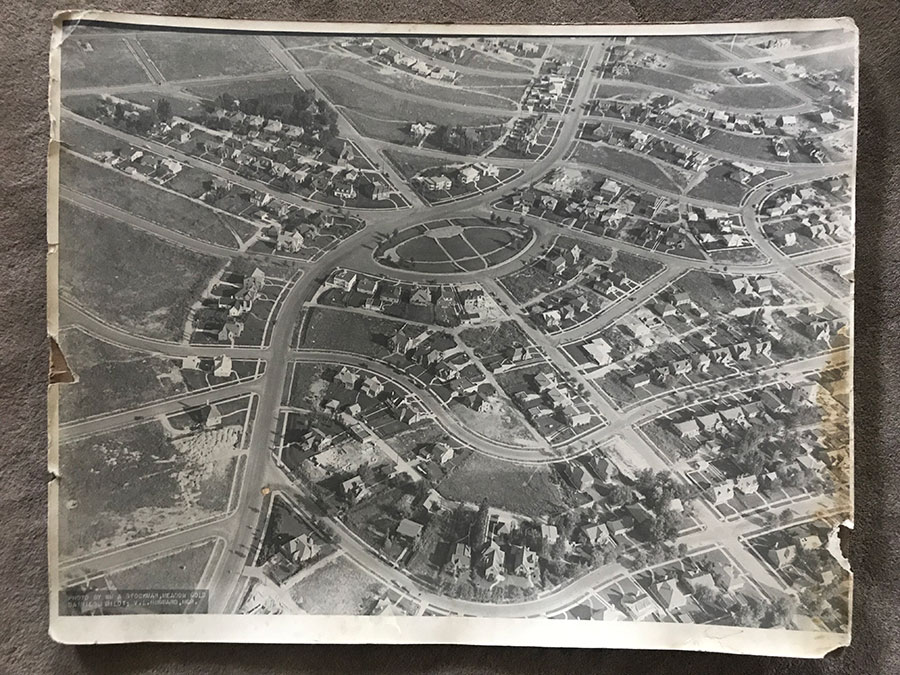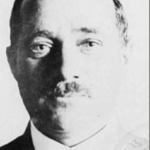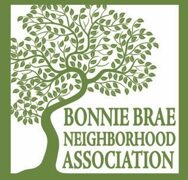
Bonnie Brae was originally developed in the 1920s on land that had been granted to the Kansas Pacific Railroad in 1870. The railroad eventually sold the land to farmers, and later it became part of the town of South Denver, one of the many small communities later annexed by Denver.
Olinger’s Vision
George W. Olinger, a prominent mortician, casket manufacturer and real estate developer, began accumulating property in the area for his land development company, Associated Industries, in the1920s. Today, the Linger Restaurant in the Highlands incorporates part of one of his former mortuaries in its signage. Olinger had been impressed by a subdivision he saw in Kansas City named Bonnie Brae, meaning “pleasant hill” in Gaelic. Borrowing the name, he strived to recreate the aura of a peaceful Scottish village in Denver. The idea was to have curved streets to create a feeling of elegance and beauty.
In 1923, the company hired the noted landscape architect Saco DeBoer to design the street system for the new neighborhood in a fashion similar to the Kansas City subdivision, and a departure from the grid system that characterized most of Denver’s streets. To demonstrate pride in the neighborhood, Olinger erected stone pillars at the entrances on Tennessee and Kentucky avenues that remain today.

Saco DeBoer was a prolific landscape architect and city planner who played a significant role in the development of Denver’s built environment, particularly the city’s parks. His work remains visible today in places such as City Park, Washington Park and along Cherry Creek, and as an advocate of Botanic Gardens, he created the plans for the Denver Botanic Gardens. He also created a sister neighborhood to Bonnie Brae called the Glens (West Colfax and Garrison) which shares the uniqueness characteristic of his designs. DeBoer was a fan of following the topography. He followed the grid in other parts of the city when already there, but when given the chance, he was a fan of the more organic style. DeBoer was a prominent figure in Denver, his name may be found in several areas around the city. There is a small historic district for him in the Rosedale area.
Subdivision fillings were completed in April 1925, the same year Olinger sold his share of the Associated Industries Company. In 1926, Mr. and Mrs. Paul S. Baily built one of the first homes in the neighborhood at 898 S Josephine. Two years later Mr. and Mrs. George W. Mueller built a house on 942 Cove Way.
Olinger sought to give the neighborhood an exclusive quality and used restrictive covenants, common at the time, to ensure it: A 1928 covenant prohibited the sale of any property to “persons of other than the Caucasian or white race…or any branch of the white race that is objectional to a majority of the owners.” The covenants also restricted the types of homes that could be built. Like most similar covenants in Denver, this one was later broken – thankfully – when an Italian family, the Nigros, moved into a house at 934 S. Josephine.
In 1928, Associated Industries declared bankruptcy, and most of Bonnie Brae fell into the city’s hands for tax debt. Further development in the area slowed as the depression gripped the country in the 1930s. Bonnie Brae grew on a house-by-house basis, resulting in a diverse and distinctive architecture still evident in the neighborhood. Several years passed before many houses were built in the area.
Neighborhood Development
The turning point in the neighborhood’s development came in 1936 when Bonnie Brae Park (colloquially known as Circle Park), which was the centerpiece of Saco DeBoer’s plan, was constructed. Homes built up around the park. Winding streets surrounding the elliptical-shaped park turned Bonnie Brae into a serene residential enclave in the midst of the city (and at one time so confused the Fire Department that a fire captain toured the neighborhood and mapped it so firefighters would know where to go).
Bonnie Brae remained largely undeveloped until 1940 when more custom home construction occurred, and Bonnie Brae began enjoying its reputation for fine living and beautiful homes. When World War II ended, housing construction boomed and most of the homes east of the park were constructed. Building continued through 1956 when the final homes were completed – “final” at the time.
As Bonnie Brae grew, businesses opened along the 700 block of University Boulevard. Carl and Sue Dire opened the Bonnie Brae Tavern in June 1934, seven months after the repeal of Prohibition, and it remains a neighborhood gathering spot. In 1942, Ken Wilson opened a Conoco station on the same block. His namesake grandson runs it today. (What other block in Denver has two family businesses with such longevity?) The Bonnie Brae Tavern, Bonnie Brae Conoco, Bonnie Brae Ice Cream, and Bonnie Brae Liquors as well as other businesses form the commercial area between Exposition and Ohio streets that even today constitute the “Main Street” of one of Denver’s most charming and walkable neighborhoods.
Bonnie Brae Today
The trademark home design that people tend to associate with Bonnie Brae is the Tudor style home with a high-pitched roof. Nonetheless, Bonnie Brae homes are an eclectic mix of Spanish, Bauhaus, Postmodern, and International design influenced by some revolutionary European designs of the times. As the neighborhood was fully built out by 1956, the last original design you will see is the one-story ranch brick (often blonde brick) north of Bonnie Brae Boulevard sometimes referred to as a Mid-Century or Post-War ranch style.
The neighborhood got a library in 1970 when the Eugene Field Branch was dedicated. The library underwent a major renovation in 1993. In 2016, community engagement meetings at the library showed that residents want a community in which they have common values, help each other, and work together to achieve a safe and healthy neighborhood.
In the late 1980s, an attempt to gain landmark status for the neighborhood failed. And as people began to feel the need for more space, this has resulted in a number of additions and pop tops, as well as original Bonnie Brae houses being scraped and replaced often with much larger homes.
Today, many vestiges of early Bonnie Brae still remain. You can find incinerators in some alleys, recalling a time when residents burned their trash. In the 1960s, those were replaced by trash barrels, and in the 1980s, by large dumpsters. Residents chafed at those, with the Denver Post reporting that some chained the dumpsters to their cars to drag them out of alleys. When the dumpsters were replaced in the 2000s, residents decried the loss of the capacious dumpsters. Even the trash in Bonnie Brae is under constant change!
Not all the residents of Bonnie Brae are two-footed. Early Denverites hunted foxes in the adjacent Polo Club, but they didn’t get them all: It’s not uncommon to see a fox trotting down a street, perhaps in search of one of the many rabbits in the neighborhood. Racoons are also around, and while a black bear was captured just a mile or so away in 2021, that’s not something Bonnie Brae has had to, um, bear. But if there’s an unofficial Bonnie Brae animal, it has to be the dog. Many residents find that walking them is great exercise and a good way to meet other neighbors. (And while Bonnie Brae doesn’t have a dog park, one is close by in Glendale.) Birders will also find the neighborhood fruitful: 325 different varieties of birds have been recorded in Denver!
Sources
“The Haunts of Washington Park,” Phil Goodstein, 2009
“Bonnie Brae” Book 4077, P. 445 (City documents)
“Abstract of Title, Bonnie Brae Lots 7 & 8 Block 6”
Coloradoencyclopedia.org
“Eugene Field Branch Library Bond Updates” Denver Public Library
Treasure Box Tours – Kevin Snow
A Walk Through Bonnie Brae CD – Greg VanBuskirk
Interviews: Michael Dire, Ken Wilson, Mary Bronniman, Debra Duke, Catherine & Harland Close
Bonnie Brae Neighborhood Association
eBird
